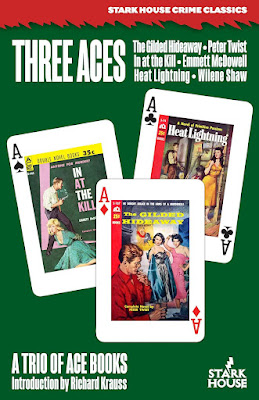“Is Betsey Blake Still Alive?”
by Robert Bloch
Ivy Books, 1987
A couple things I like: 1) stories written by
Robert Bloch; and 2) stories about Hollywood. So it was inevitable I’d love
Bloch’s “Is Betsey Blake Still Alive?”—which was originally published in the April
1958 issue of Ellery Queen’s Mystery Magazine—since it satisfies both criteria
nicely. Steve is a struggling Hollywood writer with a handful of production credits,
but without a steady gig or paycheck. His life is tough, but as the third-person
narrator says:
“Then
he met Jimmy Powers, and things got worse.”
Jimmy, at 23 years-old,
is just a kid but he drives a late-model Buick, wears silk suits, and has a
regular job as a studio public relations hack pulling down two bills a week. The
death of an aging starlet in a boating accident, the titular Betsey Blake, puts
a major Hollywood studio in a bind. Betsey’s next picture is set for a November
release, but without the starlet around to push the film, they’re afraid it
will flop. This potential disaster for the studio provides Steve—through his
new pal and neighbor Jimmy—a big opportunity to save the film with some slight-of-hand
and outright dishonest P.R. stunts like creating a sensation about Blake’s private
life and even questioning whether she is dead. Well, it plays out as one would
expect, until it doesn’t…
“Is
Betsey Blake Still Alive?” is a sharp tale with a nice twist. The narrative is
crisp with Bloch’s shiny prose and the characters, both Jimmy and Steve, are expertly
sketched into what I think of as post-WW2 sunshine boys—bright and ambitious in
a world ripe for harvest—with a grimy corruption about them. “Is Betsey Blake
Still Alive?” is a solid piece of mid-century crime that, almost seventy years
after it was written, had the audacity to surprise this 21st century
reader.
“Is Betsey Blake Still Alive?” appeared in
the excellent 1987 anthology, Suspicious Characters, edited by Bill
Pronzini and Martin H. Greenberg, along with 12 other crime stories written by
the likes of John D. MacDonald, Sara Paretsky, Ed McBain, John Lutz, and Brian
Garfield.
According
to the official Robert Bloch website, “Is Betsey Blake Still Alive,” has also
been published with the title, “Betsy Blake Will Live Forever” in volume two of
the Selected Stories of Robert Bloch.





.jpg)






